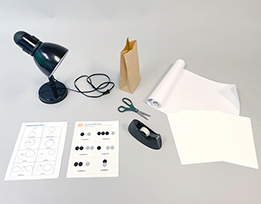Children use positional words and count children as they play Simon Says shadow games.
Materials

- Cardstock paper (or copy paper)
- Light source, such as a bright LED lamp with an adjustable head
- Paper bag (small)
- Simon Says: Shadow Cards (PDF)
- Positional Words Chart (PDF)
- Scissors
- Shadow surface (such as a large piece of paper or a sheet taped to the wall)
- Tape (for attaching shadow surface to the wall)
Preparation
- Make two copies of the Simon Says Cards on heavy cardstock paper, if possible. Cut the cards apart and put them in a small paper bag.
- Put the cards, a shadow surface (see Materials), and a bright light source in the shadow area.
- Display the Positional Words Chart.
- Outdoors: Look for a safe area with a flat surface for making outdoor shadows.
- Outdoors: SAFETY ALERT: Warn children never to look at the sun because it can harm their eyes!
Directions: Lesson 3
Guided Small Group
- Gather in the shadow area. Shine the light on the shadow surface. Have a child stand between the light and the surface. How did a shadow appear on the surface?
- Use the Positional Word Chart as you direct children to create shadows.
- Ask another child to stand next to the child in the light. Encourage children to observe their classmates and the shadows they make. Possible discussion ideas:
- How many children do you see now? How many shadows?
- What do you think will happen to the shadows if the children hold hands?
- Have them hold hands. Discuss how the shadows changed. Explain that they made a combined shadow when their hands connected. When two objects touch one another or part of one object overlaps another object, a combined shadow will appear.
- Introduce the game. Model playing Simon Says. Pull a card from the bag.
- Have children count the dots on the card. Invite that number of children to stand. Read the instructions on the card. Simon says have (one child stand next to one child). Have children make the shadow. If needed, help children use the Positional Words Chart illustrations. Point to the corresponding chart illustration as they move into position to create a shadow.
- Now, let’s count the shadows we see.
- Continue the game. Invite children to take turns assisting you (Simon) by pulling a card and counting the dots. Then you call out the positional instructions. Continue until all children have had a chance to assist Simon or make shadows. Encourage the use of comparative and positional language as children describe their shadows.
Directions: Lesson 6
Outdoors
- On a sunny day, have children gather outdoors. Let children take about 5 minutes to explore their shadows. How are you making your shadow? Where is the light coming from?
- After a few minutes, gather children together and have them spread out.
- Play the role of Simon so all children can take part in making shadows.
- Read a Simon Says card. Use the language, Simon says find (three children). Simon says have (one child stand in front of two children). Then ask, How many children are in your group? How many shadows do you see?
- When children make a combined shadow, ask, Why do you see more children than shadows?
- Have children continue to work together to create shadows. Keep a close eye on groups to be sure all children are included in making shadows.
- If children are not familiar with positioning words, you may want to use volunteers to model each instruction before children build their shadows.
- Outdoor shadow play can get silly—so have fun!


